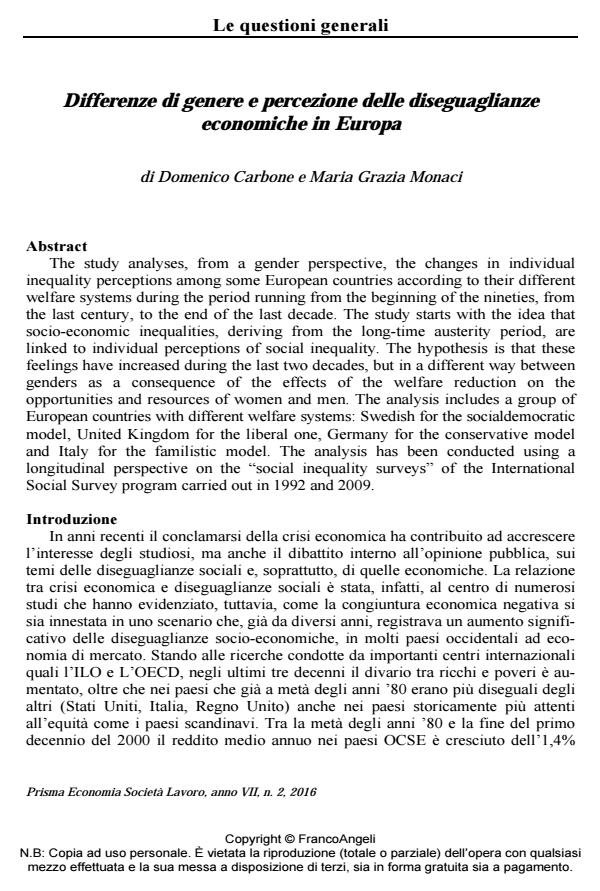Differenze di genere e percezione delle diseguaglianze economiche in Europa
Journal title PRISMA Economia - Società - Lavoro
Author/s Domenico Carbone, Maria Grazia Monaci
Publishing Year 2017 Issue 2016/2 Language Italian
Pages 18 P. 60-77 File size 242 KB
DOI 10.3280/PRI2016-002005
DOI is like a bar code for intellectual property: to have more infomation
click here
Below, you can see the article first page
If you want to buy this article in PDF format, you can do it, following the instructions to buy download credits

FrancoAngeli is member of Publishers International Linking Association, Inc (PILA), a not-for-profit association which run the CrossRef service enabling links to and from online scholarly content.
The study analyses, from a gender perspective, the changes in individual inequality perceptions among some European countries according to their different welfare systems during the period running from the beginning of the nineties, from the last century, to the end of the last decade. The study starts with the idea that socio-economic inequalities, deriving from the long-time austerity period, are linked to individual perceptions of social inequality. The hypothesis is that these feelings have increased during the last two decades, but in a different way between genders as a consequence of the effects of the welfare reduction on the opportunities and resources of women and men. The analysis includes a group of European countries with different welfare systems: Swedish for the socialdemocratic model, United Kingdom for the liberal one, Germany for the conservative model and Italy for the familistic model. The analysis has been conducted using a longitudinal perspective on the "social inequality surveys" of the International Social Survey program carried out in 1992 and 2009.
- Boudon R., (2000) The origin of values, Transaction Publishers, New Brunswick
- Carbone D., e Ceravolo F.A., (2013) “Il disagio delle classi medie in Italia tra diseguaglianze e malessere”, Sociologia Italiana AIS Journal of Sociology, vol. 4, pp. 55-79
- Esping-Andersen G., (1990) The Three Worlds of Welfare Capitalism, Polity Press, Cambridge
- Hobson B., (1990) “No exit no voice: women’s economic dependency and the welfare state”, Acta Sociologica, vol. 3, pp. 225-250
- Lane R.E., (1986) “Market justice, political justice”, American Political Science Review, vol. 80-2, pp. 383-402
- Laurin K., Gaucher D. e Kay A., (2013) “Stability and the justification of social inequality”, European Journal of Social Psychology, vol. 43, pp. 246-254
- O’Connor J., (1993) “Gender. Class and citizenship in the comparative analysis of welfare state regimes: theoretical and methodological issue”, British Journal of Sociology, vol. 44-3, pp. 501-518
- Orloff A., (2009) “Gendering the comparative analysis of welfare state: an unfinished agenda”, Sociological Theory, vol 27-3, pp. 317-343
- Runciman W.C., (1972) Ineguaglianza e coscienza sociale. L’idea di giustizia sociale nelle classi lavoratrici, Einaudi, Torino
- Svallfors S., (1997) “Worlds of welfare and attitudes to redistribution: a comparison of eight western nation, European Sociological Review, vol. 13-3, pp. 283-304
Domenico Carbone, Maria Grazia Monaci, Differenze di genere e percezione delle diseguaglianze economiche in Europa in "PRISMA Economia - Società - Lavoro" 2/2016, pp 60-77, DOI: 10.3280/PRI2016-002005